If you want to learn how to make Indian restaurant curries at home this is the place to start. Indian restaurant curry base or base gravy is the foundation of the whole thing. Get this figured out and you are on your way to making better curries than you can buy.
Indian restaurants cook a whack of different curries to order. Ever wonder how they do it? For sure they don’t have 25 curries simmering away in the kitchen.
Nobody can run a restaurant like that. They have a secret. Indian restaurant curry base.
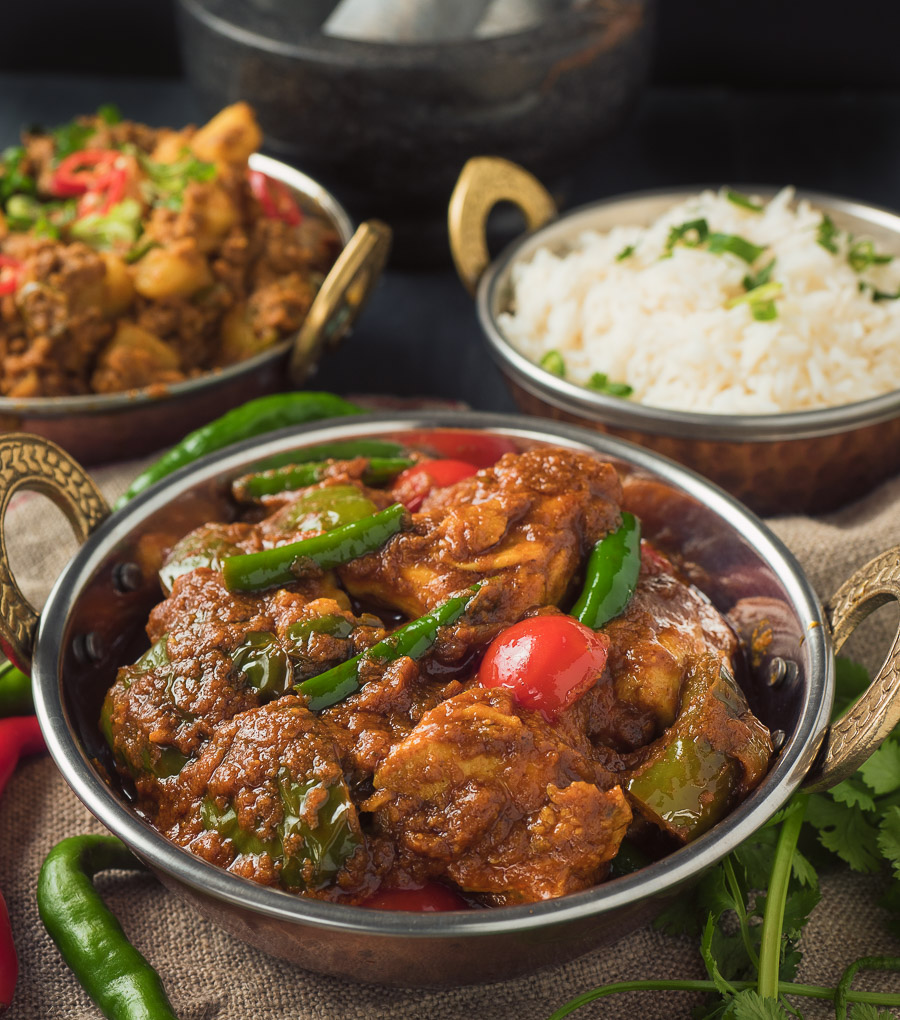
Curry base is how Indian restaurants can cook to order
It’s cooked to order and it’s done using curry base. Curry base is at the heart of every Indian restaurant kitchen. Giant pots of it simmering away.
Once I heard about it I started asking waiters. I met kitchen staff. Talked about it with a chef or two. I was on the inside. Now you are too…
Never heard of curry base? Not surprising. For the longest time it was a closely guarded secret. Even now, Indian restaurant curry base recipes are carefully guarded secrets.
A hint of carrot – ooohhhh. A bit of cabbage – aaahhh. A green pepper – ssshhhh. But that’s how it’s done.
It’s a bit ridiculous. In it’s simplest form it’s just a lot of boiled onions with some spices and oil. Seriously. Cook it up and it tastes like a weak curry onion soup. Nothing to it. Not particularly tasty.
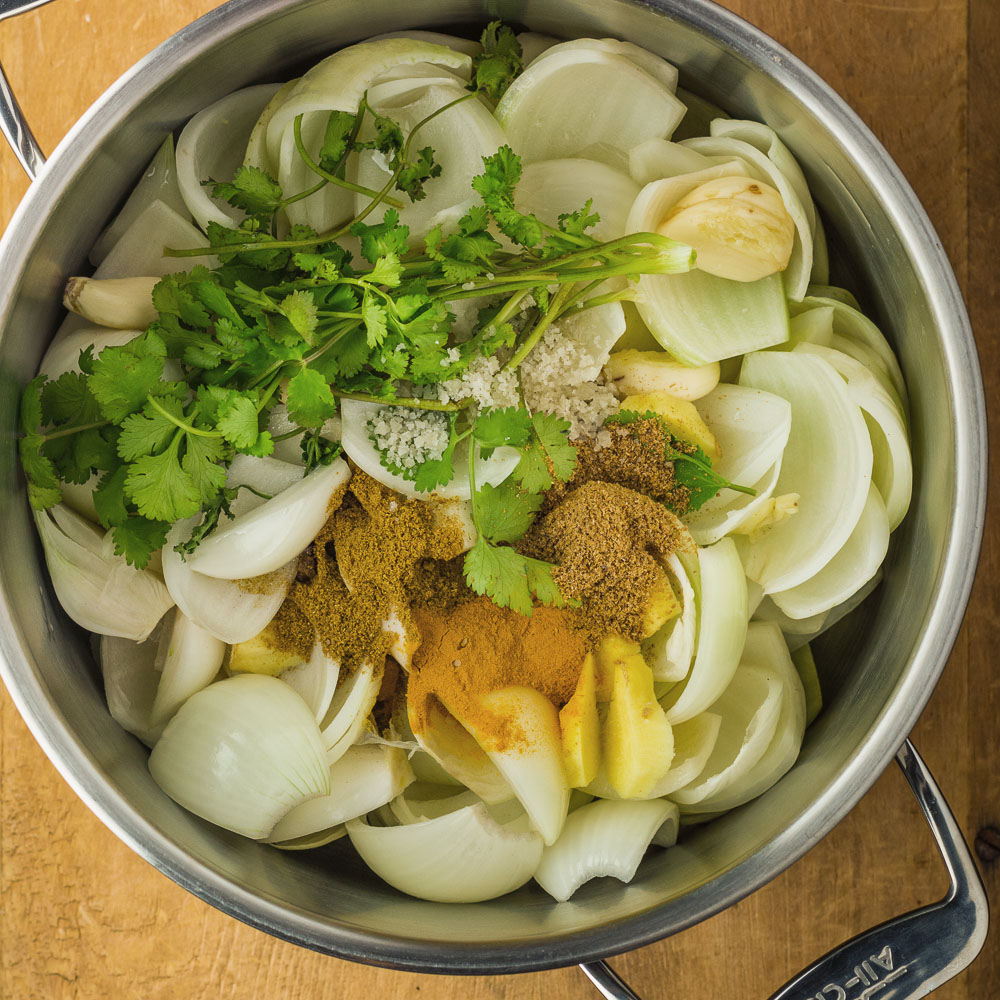
The magic is in the cooking technique
But when you layer the Indian restaurant technique on top it’s magic. Something wonderful happens to that insipid onion soup. It caramelizes. The Maillard reaction kicks in. The depth of flavour is – well it’s restaurant quality.
It’s not hard. It’s just a matter of rolling up your sleeves and getting it done. Chop some onions. Add some water and some seasoning and boil. Puree. Boil some more. Done.
You can get a quick lesson on cooking Indian restaurant curry here.
You use this base in recipes like Indian restaurant madras, lamb curry, jalfrezi or chicken tikka masala. Look around – there are lots of Indian restaurant curry recipes here.
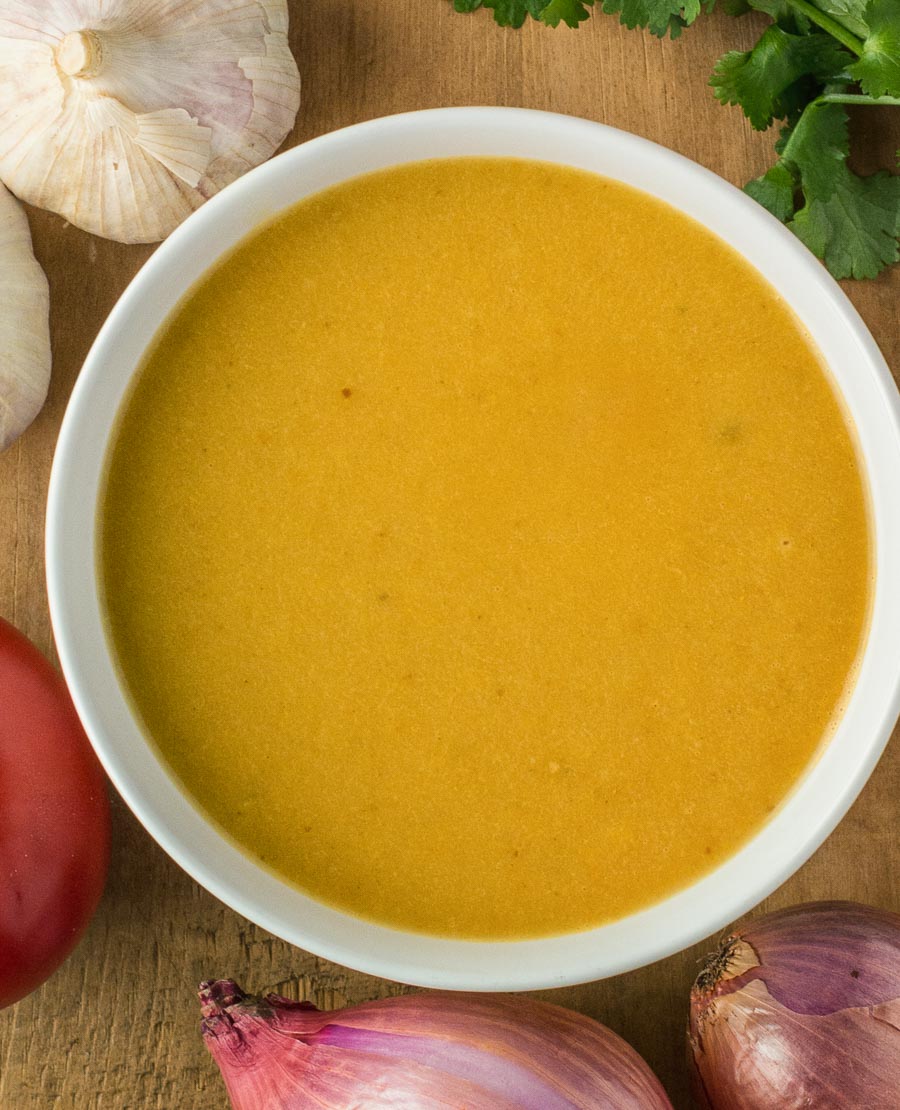
One thing to note. Indian restaurant curries are big on oil. This recipe is about as low as you can go on the oil. Don’t use less. It just won’t work. Indian restaurant curry is a lot of things but low calorie it is not.
If you want to cook Indian restaurant style curries this the first step. The real deal.
Watch the video (there’s real audio)
indian restaurant curry base
Ingredients
- 8 large onions – about 2.5 lbs peeled weight
- 6-8 cloves garlic peeled
- 1 1/2 Tbsp ginger coarsely chopped
- 1 1/2 Tbsp cumin powder
- 1 1/2 Tbsp coriander powder
- 1 1/2 tsp turmeric
- 1 1/2 tsp salt
- 12-15 fresh cilantro stalks with leaves – roots removed
- 1 cup vegetable oil
- 12 cups boiling water
- 15 oz can diced tomatoes – one small can
Instructions
Step 1
- Bring the water to a boil (a kettle works well for this).
- Quarter the onions and then break them apart into petals (roughly – two or three petals per quarter)
- Combine all ingredients except tomatoes, bring to a gentle boil and simmer, loosely covered, for one hour. Use a big pot!
- Add tomatoes, stir and simmer an additional 20 minutes
- Let cool slightly. Blend to smooth consistency. Make sure you remove the centre cap from the blender lid and cover the hole with a cloth or you will be cleaning the ceiling. Alternately you can use an immersion blender.
Step 2
- Wipe out the pot and return pureed curry base and simmer, loosely covered, until the oil separates out – this can take an hour or more. Stir the oil back into the base. At this point you can portion out the base into 2 cup portions and freeze if desired.

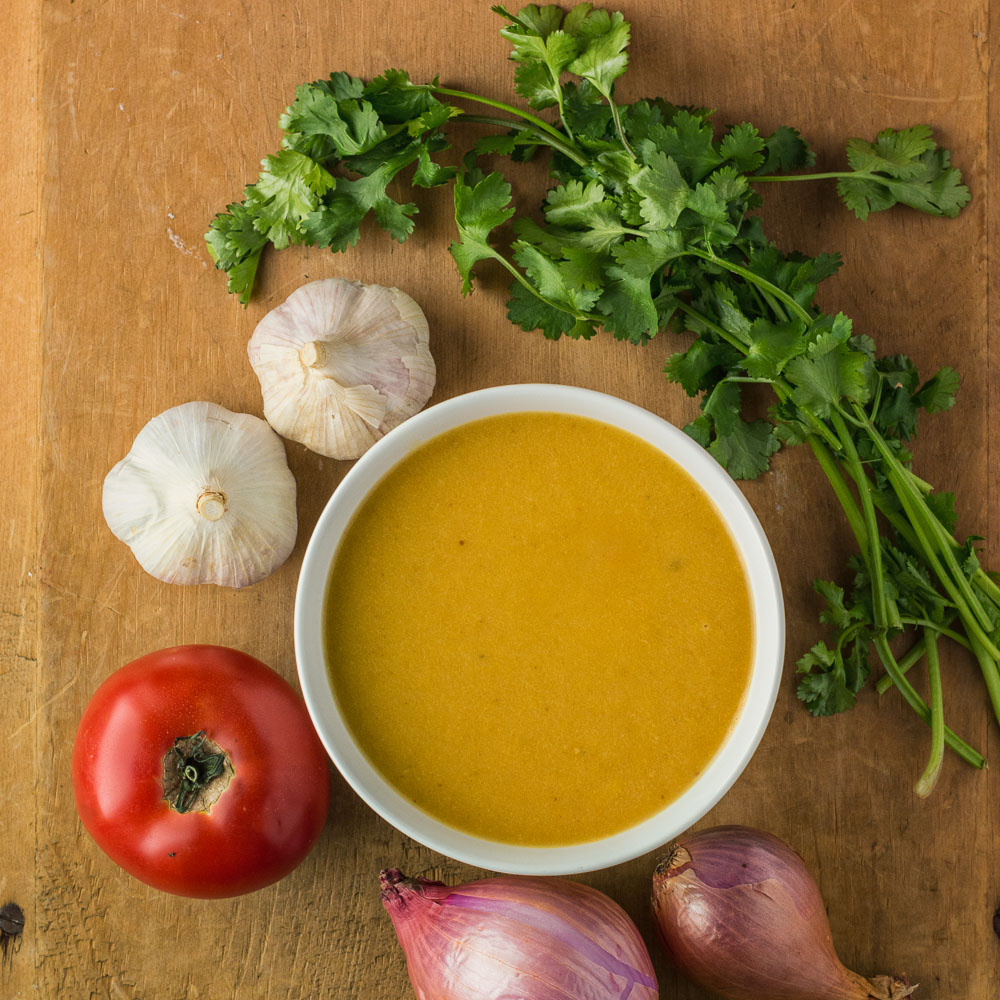

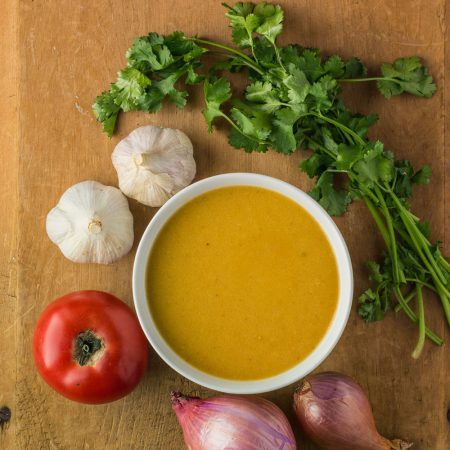
Hi
Not sure if you’ll see this on time – then again, given Lockdown. At Step 2 of the Base Stage, when you say, “simmer until the oil separates” I thought you meant to skim it but you mean to stir it into the existing pot?
Thank you from Scotland,
Lindsey
x
Yes, stir it back into the pot. Hope this got to you in time!
Hi romain,
Had this bookmarked for an age. Due to the lockdown now have time to make it!! Mine is very bland which I would expect it to be , some taste but not a great deal , nice all the same. It is very thin , like a soup , and it’s orange , unlike the bright yellow in the picture. I wondered if it was supposed to be thin , like watery?
Thanks
You are going to have fun! It should be the consistency of thin cream roughly. It sounds about right.
I’m just about to make a 2nd batch! I bottle (‘can’ for the US) the base as never have freezer space. Perfect with your Indian Spice mix as a base for many different curries. Thanks so much!
Canning. I never thought of that. Brilliant!
I used your curry base for a prawn bhuna recipe at the weekend. Amazing – went down a storm. Thanks for taking the time to create such a detailed set of recipes!
My pleasure! I’ve been meaning to get around to some prawn curries. Thanks for the reminder.
Question: I’ve recently started to dab in Indian cooking, and have found some amazing recipes (here and elsewhere), but I don’t always want to prep lots of base curry. I’ve heard that this is the “shortcut,” but how do I make 15oz of “base curry” when not wanting to use the short cut?
For example, if I wanted to make your Madras recipe without using premade curry base, is there a method for doing so?
Have you looked at the nearly restaurant style I’ve posted here? There’s a nearly restaurant madras.
Romain- just wanted to say I’ve tried other online indian recipes out there that swear they are “restaurant level” but totally fall short. Always wondered what the secret was and by some magical alignment of the universe I found your website while falling down a totally unrelated web rabbit hole. Whipped up the base and used it in your madras curry recipe and wow. Your love for food really shows and your writing style is equally bombastic. I never reach out online but I wanted to let you know that you’ve given me the key to unlocking the flavors I’m always wondering about and, in that way, made me very happy. You seem like a cool dude.
Thanks for sharing your knowledge and humor with the rest of us anonymous strangers. I know I’m not the only one who appreciates it.
Thanks for taking the time to reach out like this. Really appreciated. You made my day!
The web is a really big place. I’m glad you found me.
Totally agree! Not made any curry yet (can’t wait though!) but have been reading this blog/site like a novel that I can’t put down!! Love your style of writing .Thanks-it’s brill! ?
That is just awesome to hear. I’m glad you are enjoying it so much!
This recipe has served me very well, I absolutely love this blog! All of my friends now come to my house for an indian instead of ordering a takeaway.
Thank you very much for saying so! My friends also tell me I’ve ruined Indian restaurants for them:-)
Hi. The blurb above the recipe mentions cabbage and bell pepper, but they’re not in the actual recipe? How much of each should be used? Thanks.
I think I may not have been clear. I do not like or use these types of ingredients because they tend to colour the taste of the curry. The recipe is 100 percent correct as written. I use the posted recipe every time I make curry base.
Hi Romain- “til the oil seperates out”. I know what this is and can see when it happens but what’s the significance of this particular point? The dal I’ve just made used the exact same phrase . S
That is a very good question. I’m not sure I understand the food science behind this one I am afraid. I’ve seen people say that oil and water emulsify and the oil separates out after the water has evaporated. Obviously that’s not the case here and I’m pretty sure that’s not the case when you make a curry either.
If it’s true that the water and oil have emulsified then my guess it reaches a temperature (or sits at a certain temperature long enough) that breaks the emulsion. At that point the oil separates out. That’s nothing more than an educated guess mind you. If you ever do get a definitive answer I would love to hear it.
Oh wow, this is a revelation! Tried it last weekend and it’s absolutely fabulous. It’s by far the closes curry I’ve ever made to those I’ve had at Indian restaurants. I’d given up on trying to replicate something similar until I saw this. This will be my go-to recipe for all future currys.
Thnaks very much for posting it.
Just made my second lot of this excellent curry base.
One little tip for freezing is to pop the 2 cup portions into freezer bag, lay them flat then freeze. You can then store them like thin books in the freezer.
Also to say that a few times I cheated (sorry) and used your great base, plus a portion of garlic / ginger paste (which I also freeze in ice cube trays BUT then (cause I was short of time) added a Pataks curry pot for two. Worked well but not as good as the original.
I don’t think that’s cheating. I would call that improvising. Freezer bag is a great idea. Thanks for sharing that tip!
Patak’s really isn’t the one you want if you cheat, Nazir’s is the one, I find Patak’s is quite bitter in comparison. Anyway, great site and info, I’ve worked in an Indian restarant and the advice is spot on. Adjust things to your own tastes, but most of all, enjoy it.
Thanks for the tip. Unfortunately for me Nazir’s isn’t available where I live. I will look for it online.
Thank you as well for the kind words. It’s great to hear!
I notice that your recipe does not have any bell peppers. Over the years I think every Bir base gravy I have seen has included some green or red peppers, sometimes both. Is there a reason why you do not use peppers?
Thanks
I just don’t like any of the so called “secret ingredients”. I use base gravy as I would onions when I devise recipes. I don’t want the taste of peppers or carrots or cabbage sneaking in and colouring the flavour. Plus different curries start to taste the same I find when the base has too dominant a flavour.
Totally makes sense. I see so many base gravy recipes, and have also tried several, that have other ingredients such as peppers, cabbage, carrots, condensed milk, coconut block, chilis etc. And you end up with a curry that just tastes like base gravy. I will try your base version soon, along with your curry recipes.
Thanks
Hi Romain
I made a half batch of the curry base which is in a bowl waiting to be divided into individual portions.
I don’t know how much base is in the bowl and I don’t want to transfer it into a measuring jug to find out.
Can you tell me how many grams of curry base is one portion?
Have you a recipe for nann bread?
Jayne
I don’t know exactly but as an approximation 15 fluid ounces is 443 ml. 1 ml of water is 1 gram so around 443 grams? Safest thing to do would be put a measuring jug on your scale. Tare it to zero and add 15 fluid ounces of base. Weigh that and you will know exactly. I don’t have any thawed curry base handy to try it myself.
I am working on a foolproof chapati recipe. Once I have that naan is next.
Great recipe! I just wanted to ask can you used dry ground ginger powder or does it have to be fresh? And if you can use it, how much? Many thanks ?
Thanks! I’ve never tried this with dried ginger. I have no idea how it would turn out. Given that so many curry recipes include garlic ginger paste I would leave it out of the base before I tried it with dried.
Is fresh ginger hard to come by where you are? I hope not because fresh made garlic ginger paste is a lot better than the stuff you buy in the jars…
No I can get it fine, it’s just because I have the dried stuff handy. Thank you so much for your reply. Also when you make the curry base, if you half the ingredients for it to make a smaller amount of curry base, should you reduce the cooking time at all or does this stay the same?
Thanks again 🙂
The cooking time stays the same. But make lots. If you like making restaurant style curries you will use it up in no time.
Hello, I hope you’re well.
I have just made this & I’m not sure if the flavour is right. It’s not unpleasant but not sure if I’ve made a mistake. Please can you clear something up for me?
Is it 1 AND a half tbsp or 1 x half tsp
Is it 1 AND a half tsp or 1 x half tsp
Many thanks 🙂
It’s 1 and 1 half tsp and 1 and 1/2 tsp. I wouldn’t worry too much about it though. The curry base is pretty bland by design. The real flavours come from the actual curry recipes it is used in. Anything labeled “restaurant style” on glebe kitchen is meant to be used with this curry base.
Note the “nearly restaurant style” recipes are stand-alone and do not use this curry base.
Good luck. I’m pretty sure you will be OK.
Thank you… do you think it would be ok to reheat it & add the missing spice before letting it cool again?
No harm I don’t think. Again, given that you are adding upwards of a Tbsp of spice per individual curry I don’t think that it’s going to make much of a difference. Just remember for next time. Maybe try making a restaurant style curry first and see what you think?
Wondering if it would work to sub the veg oil with ghee? Or maybe a half and half mixture? Any idea?
Thanks
I’ve tried it with ghee. You get a more buttery base. I find it blunts the flavour of the curries but if you are after a really buttery taste (say for a butter chicken) then it could work.
oops, just added ghee instead of oil thinking I was being clever! Well let’s see how it turns out. Did you really use 2.8 litres of water in your video? I have the exact same Le Creuset pan as you and it is relying on physics to keep it in there! – very excited at the thought of finding a genuine method of copying the restaurant style.
Ghee will just make the base and subsequent curries a little more subdued. I find using ghee adds richness but mutes the flavours of the spices. The Le Creuset I use for base is the 6.3 litre size and yes, I do use 2.8 litres of water. Happy currying!
Cilantro??? Fresh Coriander in the UK! right?
Yes. Fresh coriander in the UK is cilantro here in Canada. Actually it goes by both names here to further confuse things…
Hi going to try your recipe on Tuesday can’t wait just wondering do I just throw in the cilantro or chop it up first?
Thank you
Just throw it in. It all gets pureed…
Has anybody tried making curry base in a slow cooker/crock pot. It seems ideal for it
I haven’t tried that. I don’t have a slow cooker so I don’t know if the simmer would be high enough. I have done it in a pressure cooker. That’s marginally faster but not enough that I find it worth it to dig out the pressure cooker when I have a pot and a stove handy.
This stuff is liquid gold. I used it with a few of the recipes on this site, and just finished a pork shoulder in the slow cooker with it and it came out great.
That is awesome! Never thought to use it that way.
Hi all.could you please give me the know hòw to do a balti keema.i had an illness in my throat a while ago,unfortunately from then I have to have things super mild,haven’t had an indian in year’s .ive been reading all the posts,mouth watering..please help
I’m sorry to hear that. Hope you are on the mend. I’m afraid I don’t have a balti keema recipe on the blog yet. There is a keema matar recipe here. If you left the peas out it would make for a simple and not too spicy keema.